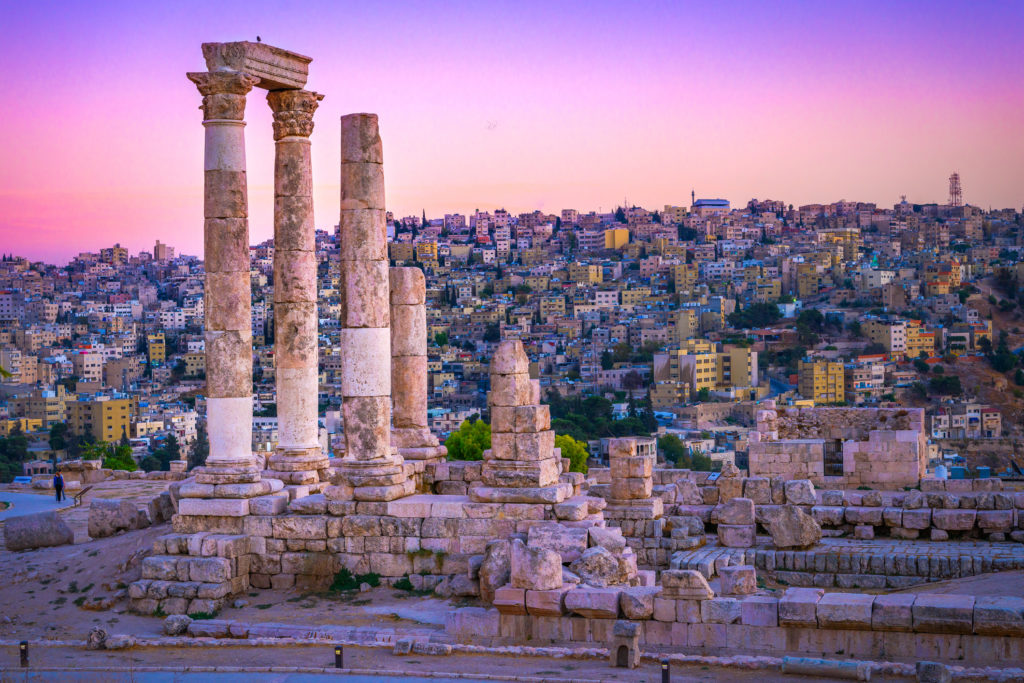- US Toll-Free:+1-888-671-5387
- International:+1-646-820-5387
- UK Toll-Free:+44-808-189-0324
- US Toll-Free:+1-888-671-5387
- International:+1-646-820-5387
- UK Toll-Free:+44-808-189-0324
- US Toll Free: +1-888-671-5387
- International: +1-646-820-5387
- UK Toll Free: +44-808-189-0324
One of the oldest cities in the world, the capital of the modern-day Hashemite Kingdom of Jordan has been inhabited in one form or another since before 7000 BCE, reinventing itself many times along the way. In Biblical times, Rabbath-Ammon was the capital of the Ammonite kingdom, which fought several wars against David and Saul. The city was conquered and renamed numerous times throughout history. For centuries it was an important stop on caravan routes, but as caravan trade declined the population shrank, and for centuries Amman was little more than a village. By the late 1800s, barely a thousand people lived there.

The city's modern history begins in late 1800s, when it was resettled by the Ottoman Turks. The Hejaz Railway, intended to connect Constantinople and Mecca, was built soon after the turn of the 20th century, bringing with it trade and waves of pilgrims undergoing the Hajj. In 1921, after the breakup of the Ottoman Empire, Emir Abdullah bin al-Hussein chose the city as the capital of the newly established Emirate of Transjordan. Lacking a palace, the Emir operated at first out of Amman's railway station, with his office in a train car.
As recently as 1947, Amman's population only numbered around 33,000, but explosive growth since that time, bolstered by Palestinian refugees and others fleeing turmoil around the region, has yielded a metropolis of nearly 3 million people. Today, the city boasts regional headquarters of many large multinational corporations and is one of the most popular tourist destinations in the Middle East.
Must See: While it feels more modern than many other Middle Eastern cities, Amman is full of historical sites, most of which are located in the downtown area. The Amman Citadel (Jabal al-Qal'a), an L-shaped hill that houses ruins dating back to the Neolithic period, is an excellent place for visitors to begin their explorations. The ruins include an Umayyad Islamic palace, the Temple of Hercules and a Byzantine basilica, all in close proximity to one another. The Citadel also houses the Jordan Archaeological Museum, whose collection features the ’Ain Ghazal statues, the oldest statues ever discovered.
Lodging: Kempinski Hotel - This chic, modern hotel opened in 2005 and features luxurious accommodations, numerous restaurants, a bowling alley, a cinema and other amenities.
Ground Transportation: Once your private jet lands in Queen Alia International Airport, you can take a bus or taxi into the city. Taxis are the most convenient way to get around, although the Jordanian tourism board recommends negotiating price before leaving on a journey. Also, many rental car companies will provide you with a driver.
Packing Tips: Amman is built atop a series of seven hills, and the city's variable elevation - with approximately 1,300' (400m) between its highest and lowest points - means that there can be pronounced shifts in temperature as you travel between neighborhoods. In winter, certain areas may have snow while others may not, for example. It's best to prepare for a variety of weather conditions. Women should be prepared to dress modestly, especially when visiting religious sites.
Recommended Books: Seven Pillars of Wisdom, on which the film Lawrence of Arabia is partially based, Â is British soldier T.E. Lawrence's (somewhat embellished) account of his experiences during the 1916-1918 Arab Revolt against the Ottoman Empire. For an alternate perspective on those same events, read Jordanian historian Suleiman Mousa's influential T.E. Lawrence: An Arab View.
Currency: The Jordanian dinar is the local currency.
Calling Code Jordan: 962
Best Travel Dates: Amman enjoys relatively mild weather compared to some of the surrounding region. Generally, the best time to visit is spring or autumn. If you visit during Ramadan, when Amman's large Muslim population will be fasting during the day, keep in mind that eating and drinking in public could offend people's religious sensibilities.


